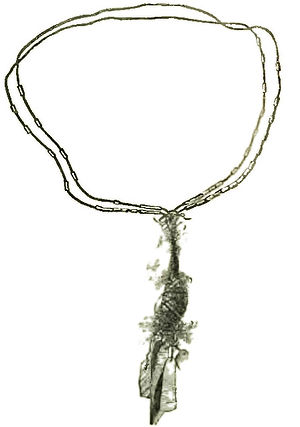are strung on twine made either of some fibre or the hair of the opossum; and, when extended, the necklace is thirty feet or more in length. In the example here figured there are four hundred and seventy-eight pieces of reed. This light and not inelegant ornament is greatly prized by the young females, and they expend a great portion of their time in making necklaces of this pattern. A reed-necklace, worn both by males and females, and named by the natives of the Lower Murray Kill-lid—formed of pieces of reed half an inch in length, and little more than a sixteenth of an inch in diameter—was presented to me by Dr. Gummow. It is well made. The fibre on which the sections of reed are strung is very fine indeed, and I cannot conjecture how it was manufactured. Dr. Gummow says that this kind of necklace was of different sizes—according as it was intended for the male or the female.

|
| FIG. 29. |
This necklace (Fig. 29) was found in a basket, described in another place, which was dropped by a woman of the Burdekin tribe, when surprised by a party of whites. The string is made of the fibre of some root, wrought into a very strong but thin twine. On this twine are strung short sections of a reed. The pendant is composed of twine coated with gum, on which are fastened human hair, feathers, and shells (unio), by a wrapping of twine made of the fur of the opossum. This ornament exhibits in its manufacture more of neatness and delicacy than is usually seen in native work. It was sent to me with the native bag in which it was found by the late Mr. Matthew Hervey.

|
| FIG. 30. |

|
| FIG. 31. |
I have received from Mackay, in Queensland, through the kindness of Mr. Bridgman, an ornament which is used as a decoration by the natives of the Far North. It is worn round the forehead, and is named Ngungy-ngungy. The shells—fragments of the nautilus—are ground into form and strung on a fine twine made of the fibre of some plant.—(Fig. 30.) Larger pieces of shell—also of the nautilus—are worn on the breast, suspended from the neck, and are called Carr-e-la. These are also strung on twine of the same kind as that used for the stringing the smaller pieces.—(Fig. 31.)
